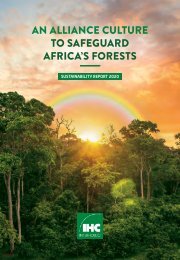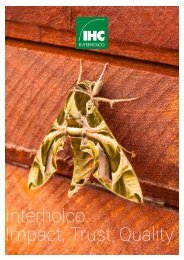Nomenclature Générale des Bois Tropicaux - 7ème édition
(english description below) Cette nomenclature est utilisée pour la mise à jour du 'Harmonized Code System' de l’Organisation Mondiale des Douanes. Dans la circulaire du 5 avril 2005, le Ministère de l’Economie, des Finances et de l’Industrie (France) reconnaît l’ATIBT comme « gardien du temple » de la nomenclature des bois tropicaux. La Commission Européenne mentionne la nomenclature de l’ATIBT comme document de référence pour la mise en œuvre du RBUE. Depuis 1954, l’ATIBT a établi et mis à jour une nomenclature des bois tropicaux faisant correspondre chaque espèce botanique avec un nom pilote reconnu internationalement. La détermination du nom pilote d’une essence est cruciale, car sa commercialisation dépend très largement de l’adoption de ce nom par le public. Le nom pilote assure la protection de l’appellation commerciale de l’essence et l’intégrité des propriétés qui lui sont attribuées, sans risque de confusion. The 1982 version of the general timber nomenclature has finally been updated as some of the 1,750 identified species, are no longer traded, while others, which were not previously included, are now on the market. The present revision has also integrated changes related to new taxonomy, in order to reflect the latest scientific developments. This Nomenclature has been used for the Harmonized Code System, updated by the World Customs Organization. The French Ministry of economy, finance and industry has given official recognition to ATIBT as the reference for the tropical timber nomenclature (NOR: PRMX0508285C of April 5th 2005). The European Commission refers to ATIBT nomenclature as a reference document for the implementation of the EUTR regulation. Since 1954, ATIBT has established and updated a nomenclature of tropical wood, linking each botanical species with an internationally recognized pilot name. A sigle wood species may have many common names; when trading across different countries, this may lead to confusion. Fixing the pilot name of a timber species is crucial, to protect the commercial denomination of the species and guarantee the veracity of the properties linked to that species, without confusion.
(english description below)
Cette nomenclature est utilisée pour la mise à jour du 'Harmonized Code System' de l’Organisation Mondiale des Douanes. Dans la circulaire du 5 avril 2005, le Ministère de l’Economie, des Finances et de l’Industrie (France) reconnaît l’ATIBT comme « gardien du temple » de la nomenclature des bois tropicaux. La Commission Européenne mentionne la nomenclature de l’ATIBT comme document de référence pour la mise en œuvre du RBUE.
Depuis 1954, l’ATIBT a établi et mis à jour une nomenclature des bois tropicaux faisant correspondre chaque espèce botanique avec un nom pilote reconnu internationalement. La détermination du nom pilote d’une essence est cruciale, car sa commercialisation dépend très largement de l’adoption de ce nom par le public. Le nom pilote assure la protection de l’appellation commerciale de l’essence et l’intégrité des propriétés qui lui sont attribuées, sans risque de confusion.
The 1982 version of the general timber nomenclature has finally been updated as some of the 1,750 identified species, are no longer traded, while others, which were not previously included, are now on the market. The present revision has also integrated changes related to new taxonomy, in order to reflect the latest scientific developments.
This Nomenclature has been used for the Harmonized Code System, updated by the World Customs Organization. The French Ministry of economy, finance and industry has given official recognition to ATIBT as the reference for the tropical timber nomenclature (NOR: PRMX0508285C of April 5th 2005). The European Commission refers to ATIBT nomenclature as a reference document for the implementation of the EUTR regulation.
Since 1954, ATIBT has established and updated a nomenclature of tropical wood, linking each botanical species with an internationally recognized pilot name. A sigle wood species may have many common names; when trading across different countries, this may lead to confusion. Fixing the pilot name of a timber species is crucial, to protect the commercial denomination of the species and guarantee the veracity of the properties linked to that species, without confusion.
You also want an ePaper? Increase the reach of your titles
YUMPU automatically turns print PDFs into web optimized ePapers that Google loves.
Liste des noms vernaculaires avec renvoi au nom pilote /// 107
NOMS VERNA-
CULAIRES
COMMON
NAMES
PAYS
COUNTRY
NOM PILOTE
PILOT NAME
Enoi NG Ovoga
Enouk GA Mambodé
Enoumnoume GA Nieuk
Entalun MY Kayu Hujan
Entedua GH Etimoé
Entelang MY Kandis
Entuyut MY Punah
Enuk GQ Mambodé
Epal CG Limbali
Epi de blé GF Wacapou
Epinde-Pinde CM Ebène d’Afrique
Eri Kire UG Acajou d’Afrique
Erima PG Benuang
Erimado NG Essessang
Erimado TG Essessang
Erun NG Tali
Esa GH Ohia
Esa-Kokoo GH Diania
Esa-Kosua GH Diania
Eseng GQ Ossimiale
Eshago NG Sougué
Esia GH Essia
Esodoum CM Kapokier
Espadeira BR Wallaba
Espavel NC Caju açu
Espina de corona BR Espina de corona
Espina de corona PY Espina de corona
Essabem CM Ebiara
Essak CM Etimoé
Essessang CM Essessang
Essia GH Essia
Essingang CM Bubinga
Essiri CG Mubala
Essoua GA Ozouga
Estopeiro BR Jequitiba
Estoraque PE Balsamo
Esungang GA Divida
Etekele CD Yungu
Eteng CM Ilomba
Eteng GA Ilomba
Etimoé CI Etimoé
Etom GA Kosipo
NOMS VERNA-
CULAIRES
COMMON
NAMES
PAYS
COUNTRY
Evam GA Bodioa
Eves GA Eveuss
Eves GQ Eveuss
Eveuss GA Eveuss
Eveuss GQ Eveuss
NOM PILOTE
PILOT NAME
Evila GA Ebène d’Afrique
Evino GA Evino
Evouvous CM Iatandza
Ewome CM Coula
Eyan GA Dibétou
Eyegh GA Nieuk
Eyek CM Eyek
Eyek CM Nieuk
Eyen CM Movingui
Eyen GA Movingui
Eyen GQ Movingui
Eyere GH Aiélé
Eyong CM Eyong
Eyoum GA Eyoum
Fak Dap TH Chickrassy
Falcata PH Batai
False Tamarind JM Sabicu
Falso Pao Brasil BR Muirapiranga
Farakalay ML Grenadillo
Faro CI Faro
Faux Tali CM Eyek
Fava amarela BR Fava amargosa
Fava amargosa BR Fava amargosa
Fava arara tucupi BR Faveira
Fava Bolocha BR Melancieira
Fava bolota BR Faveira
Fava de folha miuda BR
Timborana
Fava de Rosca BR Batibatra
Fava folha fina BR Timborana
Fava Orelha de
macaco
BR Batibatra
Fava Orelha de
negro
BR Batibatra
Faveira BR Faveira
Faveira amarela BR Fava amargosa
Faveira amargosa BR Fava amargosa
Faveira bolacha BR Fava amargosa














